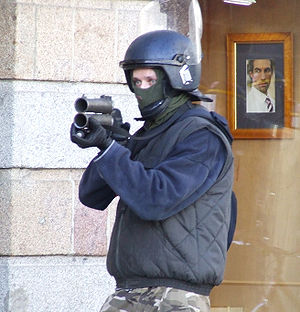Flash-ball
| Flash-Ball | |
|---|---|
 A flash-ball being fired by a French policeman | |
| Type | Less-lethal launcher |
| Place of origin | |
| Production history | |
| Manufacturer | Verney-Carron |
| Variants | Side-by-side, over-under |
| Specifications | |
| Cartridge | 44×83mm |
| Caliber | 44mm |
| Barrels | 2 |
| Action | Striker fired |
| Rate of fire | Double-action |
| Sights | Iron |
Flash-Ball is a registered trademark for a less-lethal hand-held weapon used mainly by law enforcement officers in riot situations as an alternative to lethal firearms, baton rounds, and plastic bullets. It was developed by French hunting firearms manufacturer Verney-Carron.
Characteristics
The weapon exists in two versions of caliber 44/83. The super-pro version features vertically stacked barrels and is made from metal alloys, while the compact version is made from lighter composite materials with the twin barrels side by side. Both versions of the weapon can be used to fire a variety of ammunition although a soft 44 mm rubber ball is the most common.
According to the manufacturer's own publicity, the Flash-Ball's standard round packs the stopping power of a .38 caliber handgun but considerably less kinetic energy per square centimeter, making it unlikely to penetrate the body of a normally clothed person even at ranges down to 5 meters.
This said, various human rights groups have expressed fears that the widespread deployment of such weapons could result in police being less likely to apply non-violent tactics when dealing with potentially dangerous situations.[1]
Safety concerns
Numerous eye losses, comas, and brain traumas [2] as well as major bone breakages[3][4][5] and one death due to cardiac arrest[6] have been attributed to the use of "Flash-Ball". It is particularly of note for the loss of an eye by French Yellow Vest organizer Jérôme Rodrigues, who has become a galvanizing figure in the movement. There was also a photographer taking photos of the yellow vests who was hit and lost 3 fingers. The police allegedly still continue to utilize flash balls against protestors wearing yellow eye patches with target bulleyes drawn on them. Mr. Rodrigues claims that police identified him and deliberately targeted his head for a potentially fatal injury.
Users
 France: Police
France: Police Macau: Grupo de Operações Especiais (Special Operations Group) of Macau Police
Macau: Grupo de Operações Especiais (Special Operations Group) of Macau Police Portugal: Public Security Police
Portugal: Public Security Police
See also
References
- ^ "Amnesty International Report on France 2003". Archived from the original on 14 June 2007. Retrieved 6 July 2007.
- ^ https://www.bbc.com/news/world-europe-46917989
- ^ Le Monde article of 26 June 2009, on violence in a Paris suburb
- ^ Sotiri Dimpinoudis - Twitter - photos of Flash Ball victims
- ^ Infoshop article of 9 July 2009, on eviction of squatted building
- ^ Le rôle "indiscutable" d'un tir de Flash-Ball dans la mort d'un homme à Marseille
External links
